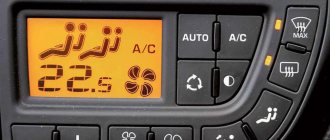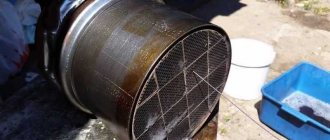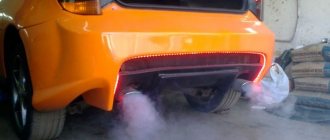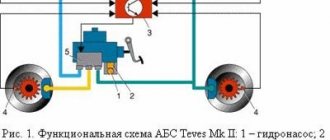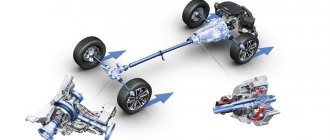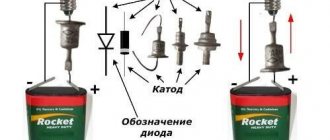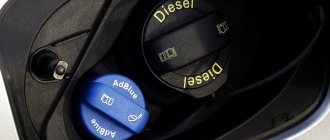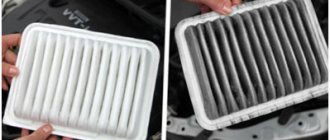Why do car windows sweat?
Sweating of the windows inside the car often occurs during rain. It reduces visibility and poses a traffic hazard. Foggy windows block up to 35% of the light flux and thereby reduce the quality of visibility and the driver’s adequate assessment of the road situation. The cause of sweating is condensation. It collects (scientifically, condenses) on the windshield from the inside. It can also be collected on any other glass - side or rear.
Condensation is small droplets of water that settle on the glass surface. Certain conditions are necessary for them to fall out. This is the so-called “dew point”, a combination of a certain humidity and temperature. For example, with an air humidity of 62%, condensation will form at a temperature of +12 °C. But at a humidity of 95%, condensation will appear already at +20 °C. Thus, condensation is guaranteed if there is high humidity in the cabin.
Note and for comparison: the usual humidity of the air that people breathe indoors is 50 - 60%. Doctors recommend maintaining humidity in children's rooms at 60 - 70%.
The process of condensation formation can be controlled by temperature and humidity. In this case, the temperature is important not in the cabin, but on the inner surface of the glass. And also air humidity. What do these factors depend on, and how can their values be influenced?
Glass temperature
Determined by the outside air temperature. In winter and autumn it is quite low, so the glass is heated to prevent condensation. Cold glass will almost always be the site of condensation. The glass is heated with warm or hot air from the ventilation slots - this is the same with windshields. Or by transferring heat from heated wires - this is how rear windows are heated.
Condensation does not form on heated glass. If it has already formed, then when the glass is heated, the water droplets dry out within a few minutes. Therefore, in humid weather, the blowing and heating of the windows is turned on immediately, even before leaving the garage, in order to prevent them from fogging up.
Air humidity
The humidity of the air inside the car is the second factor that determines the fogging of the windows. When landing in the cabin, the humidity corresponds to the outdoor space. Afterwards, it may decrease if the hood works well enough.
When you get into your car during a rainstorm, you bring with you 90 percent humidity and condensation on the windows. Therefore, during rain, without waiting for moisture to appear, it is necessary to turn on enhanced exhaust ventilation of the cabin. The amount of moisture in the cabin air will be constantly replenished if 4 - 5 people travel in the car. In 1 minute, a person exhales 1 gram of water, which also remains in the cabin and can condense on the inner surface of the glass. An exhaust fan should also be running to remove moisture from passengers' breath.
A very useful and relevant article from our specialist talks about how a rain sensor works.
You can find out detailed information about whether it is possible to turn on the air conditioner in winter from the article by our author.
We also recommend that you study interesting material from an expert who is devoted to such a pressing issue as anti-rain for car glass.
To remove condensation, it is necessary that the air circulation is turned on “from the machine”. And one more thing: for high-quality ventilation, the cabin filter and evaporator must be clean.
In order to prevent condensation, it is necessary to turn on hot air blowing on the glass and increased exhaust ventilation of the car interior.
You can also turn on the air conditioner - it will remove moisture and condensation in a few minutes. If the car is just leaving the garage, it will take time to warm up the engine. And only after this it will be possible to heat the glass with hot air. An exception to this rule would be the option of a separately operating stove. In this case, glass heating can be turned on from the start.
What to do with a cloudy windshield
To remove fogging from the front window, minimize the level of humidity in the cabin. For this:
- Regularly ventilate, dry the interior, restore normal air circulation. All this must be done during the rainy season.
- Dry rubber mats in a timely manner.
- Shake water and snow off your shoes when getting into the car.
- Sweep snow from the hood grille (if you don’t do this, the working stove will melt it).
- They monitor the cleanliness and serviceability of air filters, air conditioning, and stoves.
Treating window openings with a powerful stream of air quickly solves the problem of fogging. You need to simultaneously turn on the fence mode outside and the stove in the cabin.
You can apply a product to your windshield to prevent fogging. They use special auto chemicals or folk recipes.
Shaving foam
This is an effective and affordable glass defogger. Glycerin has a corresponding effect - it creates a thin protective film that prevents moisture condensation.
Moisture in the cabin: what to do?
If there is chronic humidity inside the car, it is worth checking the condition of the underbody and raising the rugs. If it is humid under them, the tendency to fog will be increased. What should I do?
- Dry the upholstery under the rugs.
- Place a porous absorbent substance under the driver or passenger seats. Cat litter is often used. Salt also works. It absorbs not only moisture, but also unpleasant odors.
- Check the condition of the seals and, if necessary, change them so that rainwater does not enter the car interior.
- Check the serviceability of the engine cooling system - it can also be a source of moisture for the interior space.
Be sure to read the article about which car lock defroster to buy or how to make it yourself.
Find out what benefits a heated windshield gives a driver and how to install this function correctly in our article.
For more detailed information about the windshield washer, its features and selection rules, read the material from our expert.
To be fair, it is worth noting that on many modern cars the windows do not sweat. Their hood and glass blowing work quite well. Therefore, there are no conditions for condensation to form on the glass. The issue of fogging is more relevant to cars of the domestic auto industry with insufficient ventilation and clogged filters, with a faulty heating system on the rear window. Thus, the question of an anti-fog arises.
Removing excess air humidity in the car interior
To get rid of the effect of glass fogging, you need to control the humidity in the car interior. To do this, it is enough to ensure that water does not accumulate in the cabin, wet rags after wiping surfaces, or snow from the feet of the driver and passengers. The more moisture there is in the cabin, the more difficult it will be to deal with fogging. Therefore, there are several methods for increasing the efficiency of interior drying:
- remove all excess moisture from the interior, pour water out of the mats and wipe them;
- throw all rags that need to dry into the trunk of the car;
- talk less, especially when there are four or five people in the cabin;
- put several packs of table salt in a paper bag;
- Wrap some cat litter in a light rag in an inconspicuous place.
As you can see, there are methods for getting rid of excess moisture. This is one of the most effective preventive options for eliminating the problem. However, it is not always possible to absorb enough moisture to prevent fogging of the windows in the cabin. Most likely, you will have to additionally clean the glass themselves, and perhaps treat them with something special to avoid negative effects.
Means for treating foggy glass
To solve the problem of fogging, the automotive industry produces various glass treatment products. They are called anti-fog and anti-rain. They come in the form of aerosols or liquids and are sold in auto chemical stores at an average, affordable price.
Almost any car window defogger is alcohol-based. This is a fairly reliable product that reduces the amount of condensation on the glass and improves visibility during rain. However, there are situations when there is no ready-made anti-fog agent, but you need to go. It’s raining outside, 5 people are sitting in a car, and condensation is constantly forming on the windows. What home remedies can replace auto chemicals?
DIY anti-fog
To solve the problem at home, you can use improvised means that are easy to buy at a hardware store or those that you usually have at home. Their action is as follows - scientifically speaking, they should reduce the surface tension of the liquid. In this case, condensation on the windshield or other glass will not be retained. Drops will roll down without reducing visibility.
How can you reduce the surface tension of water, and which of these substances can be used in the car interior? How to make a homemade glass defogger with your own hands?
We also recommend that you read a detailed and up-to-date article on how to make a shock absorber for a car with your own hands.
More details about how to properly tint car windows, which is important for the owner to take into account, can be found in the material from our author.
You can learn about why a hood deflector is needed, how it protects the glass from insects and how it is installed in the article by our specialist.
A detailed article from our author will tell you how to repair a crack on a car windshield.
Soap
The simplest remedy for foggy windows. The soap contains glycerin and surfactants. They allow you to reduce the surface tension of water molecules and thereby remove condensation from the surface of the glass.
Surfactants or surfactants are found in many detergents and washing powders. Therefore, you can use not only soap, but also other detergents. Unless they contain chlorine, phosphates, formaldehydes.
To prevent condensation from forming, soap is rubbed on the inside of the glass. You can draw a grid or stripes and then rub them on the glass with a rag. Heat is necessary for good rubbing. Therefore, if you “wash” the windows in the cold, do it after driving the car in a warm interior.
Glycerin and alcohol
Mix glycerin and alcohol, then wipe the glass with the resulting mixture - the easiest option is to make a car window defogger with your own hands. Glycerin contained in soap reduces the surface tension of water droplets. However, its separate use leads to the formation of a greasy film on the surface of the glass. Fine dust and debris stick to this film. To prevent the formation of a film, glycerin is diluted with alcohol. At the same time, alcohol itself is also a means that reduces surface tension. When combined with glycerin, it loses its pungent odor and becomes an ingredient.
The ability of glycerin to absorb alcohol odor is used in the production of moonshine. Glycerin is added to home distillate and passed off as a factory product.
Mixing ratio: 1 to 10, where 1 part glycerin and 10 parts alcohol.
Pure glycerin, without mixing with alcohol, creates a greasy film on the surface of the glass. It produces glare at night, under lamplight or from headlights. Therefore, pure glycerin is not suitable as an anti-fog agent.
Glycerin and ammonia
By itself, ammonia reduces surface tension and prevents condensation. But its effect on the human body can hardly be called healing or positive. Ammonia is used for fainting. It speeds up breathing and increases blood pressure. In addition, it irritates the mucous membranes of the eyes and respiratory tract, causing lacrimation, coughing, and headaches. Even in small concentrations, ammonia can cause breathing problems.
After treating the glass with ammonia, it is necessary to ventilate the car well.
It is better not to wipe car windows with pure ammonia, but to use a mixture of ammonia and glycerin to wash them. The components are taken in the following ratio:
- 0.5 glasses of water;
- 1 glass of glycerin;
- 5 drops of ammonia.
The resulting solution is used to wipe car windows inside and out. This solves several questions at once:
- get rid of condensation;
- the outer surface will become less dirty;
- raindrops will quickly roll down;
- ice – freezes less, appears at lower temperatures.
Shaving gel
Another handy car window defogger that contains surfactants is shaving gel or foam. The glass inside the car is rubbed with gel. To do this, squeeze it onto a paper napkin and rub the glass until clean. The amount of gel is a few drops. Grind until transparent.
WD – handy auto chemicals
If an anti-fog agent is a special substance that needs to be bought at a car store, then WD is a rust remover liquid, which is often stored in a car enthusiast’s garage and is used for various purposes. You can also treat glass with WD solvent to prevent it from sweating.
Folk remedies for glass fogging
- Mix glycerin and alcohol in a ratio of 1 to 10, apply with a rag to the glass from inside the car.
- Take a cigarette with tobacco, crumble the contents onto a napkin or rag, and rub it into the windshield.
- Treat the glass with foam or shaving gel.
- In warm weather, you can use a solution or a soap net.
- Apply potato juice to the surface.
These actions will have an effect, but by themselves they are not entirely convenient. It is necessary to look for ingredients, mix them somewhere, and calculate proportions. The option with tobacco can significantly clog the dashboard and stove. Therefore, from the point of view of simplicity, ease of use and reasonable price, it is more rational to buy a good car window defogger . But we’ll tell you below how to determine the most suitable option and understand the brands.
Auto chemicals: how to use correctly
Store-bought anti-foggers are auto chemical items. Almost all of them are made on the basis of technical alcohol, to which chemical components are added - flavorings, thickeners, preservatives. For the auto chemicals to work effectively, the following rules must be observed.
- The anti-fog agent should be sprayed or applied to clean, washed and dried glass. Definitely dry.
- Can be applied in two or more layers, several times. This will increase the operating time of the product.
- Renew the substance in a timely manner, apply the solution or aerosol anew every 2 weeks.
